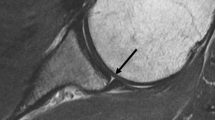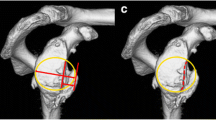Abstract
Background
The bare spot of the glenoid fossa is a normal cartilage defect seen frequently in adults. It has been used on arthroscopy as a landmark for the center of the glenoid fossa. There are no reports of this variant in children, but we have noted it on some pediatric clinical shoulder MRI studies.
Objective
Our main purpose is to evaluate the incidence of the bare spot in children and define location and MRI features.
Materials and methods
Shoulder MRI studies (total 570) from 2004 to 2008 were reviewed. Children were divided into two age groups: group 1, 0–10 years (n = 200), group 2, 11–20 years (n = 370).
Results
A total of 12 bare spots (2.1%) were identified; all were seen in group 2. Eight (67%) were central and four were eccentric in the glenoid fossa. All showed a well-marginated focal cartilage defect containing hyperintense joint fluid or contrast agent. Three also had air.
Conclusion
The bare spot is seen in children. The absence in children younger than 10 years and the low incidence in the second decade support the proposed acquired nature. Familiarity with this finding is important so as not to misinterpret it as a pathologic condition.




Similar content being viewed by others
References
Guntern DV, Pfirrmann CW, Schmid MR et al (2003) Articular cartilage lesions of the glenohumeral joint: diagnostic effectiveness of MR arthrography and prevalence in patients with subacromial impingement syndrome. Radiology 226:165–170
Beltran J, Rosenberg ZS, Chandnani VP et al (1997) Glenohumeral instability: evaluation with MR arthrography. Radiographics 17:657–673
Stoller DW (1997) MR arthrography of the glenohumeral joint. Radiol Clin North Am 35:97–116
Sanders TG, Tirman PF, Linares R et al (1999) The glenolabral articular disruption lesion: MR arthrography with arthroscopic correlation. AJR 172:171–175
Yu JS, Greenway G, Resnick D (1998) Osteochondral defect of the glenoid fossa: cross-sectional imaging features. Radiology 206:35–40
Ly JQ, Bui-Mansfield LT, Kline MJ et al (2004) Bare area of the glenoid: magnetic resonance appearance with arthroscopic correlation. J Comput Assist Tomogr 28:229–232
Burkhart SS, Debeer JF, Tehrany AM et al (2002) Quantifying glenoid bone loss arthroscopically in shoulder instability. Arthroscopy 18:488–491
Aigner F, Longato S, Fritsch H et al (2004) Anatomical considerations regarding the “bare spot” of the glenoid cavity. Surg Radiol Anat 26:308–311
Resnick D, Kang HS (2007) Shoulder. In: Resnick D, Kang HS (eds) Internal derangements of joints, 2nd edn. Saunders, Philadelphia, pp 713–1122
Warner JJ, Bowen MK, Deng XH et al (1998) Articular contact patterns of the normal glenohumeral joint. J Shoulder Elbow Surg 7:381–388
De Wilde LF, Berghs BM, Audenaert E et al (2004) About the variability of the shape of the glenoid cavity. Surg Radiol Anat 26:54–59
Tena-Arregui J, Barrio-Asensio C, Puerta-Fonolla J et al (2005) Arthroscopic study of the shoulder joint in fetuses. Arthroscopy 21:1114–1119
Fealy S, Rodeo SA, Dicarlo EF et al (2000) The developmental anatomy of the neonatal glenohumeral joint. J Shoulder Elbow Surg 9:217–222
Burkhart SS, Danaceau SM (2000) Articular arc length mismatch as a cause of failed Bankart repair. Arthroscopy 16:740–744
Burkhart SS, De Beer JF (2000) Traumatic glenohumeral bone defects and their relationship to failure of arthroscopic Bankart repairs: significance of the inverted-pear glenoid and the humeral engaging Hill-Sachs lesion. Arthroscopy 16:677–694
van der Sluijs JA, van Ouwerkerk WJ, Manoliu RA et al (2004) Secondary deformities of the shoulder in infants with an obstetrical brachial plexus lesions considered for neurosurgical treatment. Neurosurg Focus 16:E9
Author information
Authors and Affiliations
Corresponding author
Rights and permissions
About this article
Cite this article
Kim, H.K., Emery, K.H. & Salisbury, S.R. Bare spot of the glenoid fossa in children: incidence and MRI features. Pediatr Radiol 40, 1190–1196 (2010). https://doi.org/10.1007/s00247-009-1494-0
Received:
Revised:
Accepted:
Published:
Issue Date:
DOI: https://doi.org/10.1007/s00247-009-1494-0




